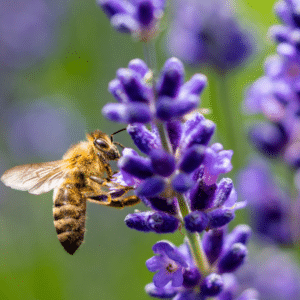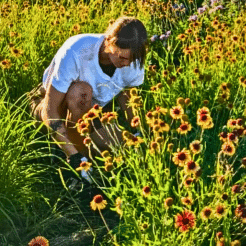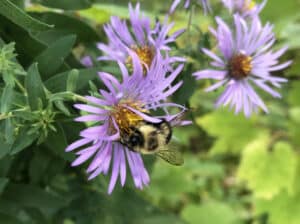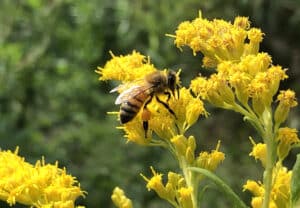
Let’s Plant with Dutchman’s Gold
Let’s Plant!
Sierra Club Canada is planting 10 million seeds across Canada with Dutchman’s Gold, an Ontario based honey and beehive wellness company.
Did you know…

There is an amazing diversity of bees in North America – an estimated 3600 species! – some of which can find a home in our very own backyards, community gardens, and local green spaces!
Bees are needed to pollinate most of our food crops as well as many native plants and flowers. Bees and other pollinators alike pollinate about one third of our crops. Unfortunately, almost one third of bee species are threatened, and two out of five pollinating insect species (critters like butterflies and hummingbirds too) are at risk of extinction. “Why are they at risk”, you may ask. Well, pollinator populations are declining due to habitat loss. However, this loss is preventable – if we act together to create places where pollinators can thrive!
We’re partnering on Let’s Plant! because at Dutchman’s Gold, they’re committed to creating a world that buzzes with life.
With every purchase of a Dutchman’s Gold product, they’ll be contributing to the Let’s Plant! initiative to plant seeds across Canada! Working together our goal is to plant 10 million seeds across Canada in 2025. But we can’t do it alone! We need you and your friends and family to join us in this vital initiative.
How can I participate?
- Being a community organizer to receive and give the seeds to those who want to be part of action on the ground.
- Securing some seeds for yourself and those on your street – let’s work out how to get the seeds to you!
- Have a bigger project or want to start a seed orchard? Let us know.
- Your idea that we haven’t covered here!
Drop us an email at info@sierraclub.ca with the subject line ‘Let’s Plant.’ to let us know how you want to help! Let’s Plant.

Photo from our Sierra Club Canada wildflower garden in Winnipeg.
You can also find out more about the campaign at the Dutchman’s Gold website.
Working with our Let’s Plant! initiative, we want to inspire people to nurture native flowering plants in their backyards and communities to create safe havens for bees.

Bee photo by / par Heather McKinnon
Here at Sierra Club Canada, we have extensive experience in the areas of protecting and restoring biodiversity. We can support Dutchman’s Gold’s commitment to ensuring meaningful actions to create pollinator habitats by providing our expertise in native plant selection, cultivation techniques, and beyond. Our Let’s Plant! partnership offers Sierra Club Canada volunteers an opportunity to take action on the issue of restoring important habitats, enhancing native plant diversity, and supporting sustainable local food.
Seeds by Region:
iNaturalist
Have some seeds and want to participate in our project’s database? Click this link! Let’s Plant iNaturalist Page
If you have seeds, plant them, and submit to this project or project journal, we gain a more comprehensive understanding of where people plant and our positive impact.
What is iNaturalist?
iNaturalist is a citizen science-based, global database where people can contribute biodiversity information to help track species (flora and fauna) and any pest/disease.
Glossary
Not sure what something we’ve discussed means?
Here are some definitions of terms we’ve commonly used to help jumpstart your knowledge and preparation for planting.
Aggressive:
Plants that are native to a region but spread vigorously and may dominate a site, especially in disturbed areas.
E.g.
- Mountain Mint (Pycnanthemum virginianum)
- Grass-leaved Goldenrod (Euthamia graminifolia)
Invasive:
Non-native (introduced) species that spread rapidly and cause harm to the environment, economy, or human health.
E.g.
- Japanese knotweed (Fallopia japonica)
- Garlic mustard (Alliaria petiolata)
Invasive v. Aggressive
| Characteristics | Invasive, Introduced Plant | Aggressive, Native Plant |
| Origin | Non-native | Native |
| Ecological Role | Disruptive, displaces natives | Part of native ecosystem |
| Biodiversity Impact | Typically negative | Often neutral or mixed |
| Control Importance | High priority for removal | May need management, not eradication |
| Wildlife Value | Low (few animals use it) | Moderate to high (supports native fauna) |
Chelsea Chop:
Chelsea Chop is a pruning technique used in late spring (typically around the time of the Chelsea Flower Show in the UK, which takes place in late May). It involves cutting back certain perennials by about ⅓ to ½ to encourage flower growth, prevent flopping, and delay or stagger flowering.
Germination:
Germination is the process by which a seed develops into a new plant. It begins when the seed absorbs water, swells, and activates enzymes that start growth. The seed’s embryo then breaks through the seed coat and begins to grow roots (radicle) and shoots (plumule), eventually becoming a seedling. Some plants have more complicated processes to activate germination, while some are quite simple.
In short:
Germination = the sprouting of a seed into a plant
Planting:
Planting is the act of placing seeds, seedlings, or plants into soil (or another growing medium) so they can grow. It involves preparing the ground, positioning the plant material correctly, and often covering it with soil and watering it.
In short:
Planting = putting seeds or plants into the ground to grow
Acknowledgements
We recognize that the plants we list here may hold different names and carry deep cultural, spiritual, and historical significance for many Indigenous Nations across what is now called Canada. These names reflect rich and diverse Indigenous languages, and relationships to the land.

Bee photo by / par Heather McKinnon
Sierra Club Canada is committed to listening and learning. If you are willing to share your knowledge and help us better understand the Indigenous names and cultural significance of these plants, we welcome and encourage you to reach out.
With respect and humility, we thank all those who continue to share their stories, teachings, and connections to the land.
Thank you to Prairie Moon Nursery for allowing us to share their information.


